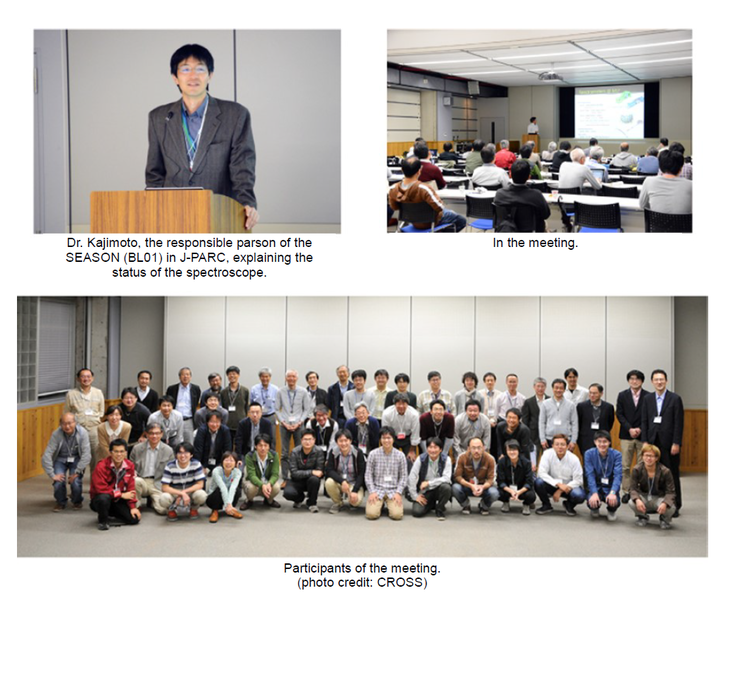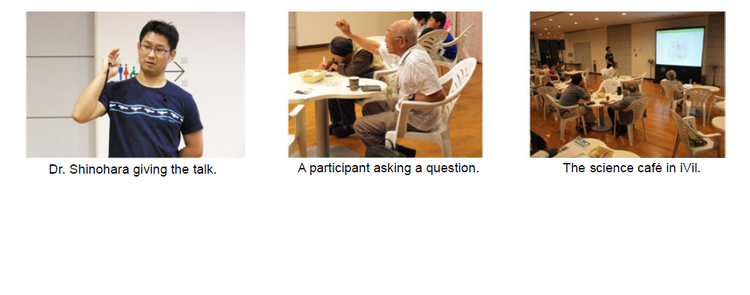J-PARC NEWS October 2017 (Issue #150)
■ T2K(Tokai to Kamioka)-NOvA (NuMi Off-Axis ve Appearance) joint meeting(October 15-18, J-PARC)
The joint meeting of the T2K experiment of J-PARC and the NOvA experiment, which is performed using equipment at the United States Fermi National Accelerator Laboratory, was held for 3 days from October 15th at the J-PARC Center. T2K has been observing the difference in the vibration of neutrinos and antineutrinos, attempting to validate the differences in nature of neutrino particles and antiparticles (CP symmetry violation). Both experiments plan to accumulate enough data and conduct analysis over the next few years, then perform joint analysis, which will allow them to study with enhanced physical accuracy. In the meeting, both groups held extensive discussions to coordinate necessary simulations for the analysis, programs, measuring methods, etc. Also, prior to this meeting, the annual T2K collaborative meeting was held for 6 days from the 9th. Reports were given, including a report that stated the probability of characteristic differences had increased to 95% (J-PARC News #148 issue) from analysis results of data accumulated up to April 2017, in addition to a report on remote control operation of proton beam window replacement, which took place for the first time since the facility began its operation.
■ The MLF Chopper Meeting "DIRECTION 2017" was held (October 16-17, IQBRC)
The Material and Life Science Experimental Facility (MLF) is equipped with 4 "chopper neutron spectrometers" (BL01、12、14、23*), which rotate a neutron shield disk with very narrow slits at high-speed to chop out neutrons of certain energy levels that go through the slits. Many unique research accomplishments have been made from neutron inelastic scattering measurements utilizing the equipment. This joint meeting of the various equipment users was held at the Ibaraki Quantum Beam Research Center (IQBRC), aiming to revitalize utilization of the chopper neutron spectrometers for research, regardless of equipment or research field. The meeting offered 23 seminars, on topics such as current conditions of the equipment, sample environment and software, in addition to examples of recent experiments and data analysis. The facility representatives and users deepened their understanding of each other through active and casual question-and-answer sessions. *4D-space access neutron spectrometer "4SEASONS" (BL01), high resolution chopper spectrometer "HRC" (BL12), cold-neutron disk-chopper spectrometer "AMATERAS" (BL14), polarization analysis neutron spectrometer "POLANO" (BL23, began commissioning in FY20017)
■ Participated in the MIRAI Seminar (Oct. 17-18, Lund University, Kingdom of Sweden)
In the city of Lund, Sweden, construction of European Spallation Source (ESS) is in progress, aiming to start its operation in 2019. It is a joint research facility operated under a legal framework of the European Research Infrastructure Consortium (ERIC) (an organization of 12 European countries). The city, which plans to build a scientific research district with ESS as its core, will strongly press ahead with the "MIRAI project", which will conduct collaborative research at Japanese research facilities, such as J-PARC, and 17 universities from both countries, and foster human resources. As part of the project, the first "MIRAI Seminar" was held at Lund University for 2 days from the 17th. Participants from Japan included not only the J-PARC Center, but also research organizations, such as SPring-8 and Waseda University, interested parties of the university, MEXT, and JST. They had lively discussions about the possibilities that may be delivered by large research facilities to research development and society.
■ T2K project, NHK World TV "Japanology plus"(October 3)
"Japanology plus" is a TV program on the NHK World channel, which is broadcast all over the world in 18 languages, and its 55th episode was titled "Particle Physics Research". It featured T2K experiments in Tokai, where J-PARC also operates an experiment facility. On September 7th, the TV crews came to gather information about the accelerator, which is equipped with superconducting magnets and transports proton beams from the MR accelerator to the target, where neutrinos are created, in addition to the near detectors in close proximity, which analyzes created neutrinos for their energy, etc., and more. The episode was first aired on October 3rd with impressive videos.
■ Presented a nuclear transmutation technology using an accelerator at an exhibition of the IAEA General Conference (September 18-22, IAEA headquarters/ Austria)
The Japanese booth at the IAEA General Conference exhibition, which was held at the IAEA headquarters, exhibited a model of an Accelerator-Driven System (ADS) as a cutting-edge nuclear energy technology and presented the latest research on partitioning and transmutation technology which utilizes ADS. During the opening ceremony of the booth, Toshinobu Sasa, Target Technology Development Section leader of the J-PARC Nuclear Transmutation Division, explained the current status of research and development to Masaji Matsuyama, Minister of State for Science and Technology Policy. In addition, there was an exchange of opinions about research progress and the effectiveness of the partitioning and transmutation technology with visitors, such as government officials of each country and IAEA technology staff.
■ 9th J-PARC Hello Science " 'Seeing' the world with neutron: Let's see through materials using neutrons" (September 29, Tokai-village Industry and Information Plaza "iVil")
J-PARC Center held the 9th Science Cafe, and Takenao Shinohara of the Neutron Instrumentation Section gave a talk on research developing at J-PARC's neutron beam line "Raden (Energy Resolved Neutron Imaging System)”. That is "visualization technique" research, seeing the inside of materials non-destructively. He explained that neutrons give a view very different compared to X-rays, which are also radiation. He also talked about the characteristics of neutrons. In particular, they are very sensitive to light elements, for example hydrogen. As a research example of such characteristic, which has the potential for improving fuel efficiency of automobiles, he gave some concrete examples, such as an observation video of fluid flow inside an air conditioner. Furthermore, observation CT images of the inside of a Japanese sword were presented, indicating that such a technique is effective for cultural asset research, and thus its use may expand to other fields. The audience asked many questions. The Cafe ended in lively mood.
■ Participated in the 5th Ozora Marche 2017 with "J-PARC Science Experiment Corner" (October 21, Tokai-village)
This was the 4th consecutive participation of J-PARC in "Ozora Marche", an open market held at the grounds of "Daijingu Shrine" and "Muramatsusan Kokuzoudou" in Tokai-village Muramatsu. We set up a corner to have participants experience fundamental science that supports J-PARC research. As well as the annual superconductivity roller coaster experiment, our liquid nitrogen (-196oC) experiments included an experiment using liquid nitrogen to cool carbon dioxide and oxygen, which are usually in a gaseous state. The audience observed that carbon dioxide and oxygen are cooled and solidified (to powder), and one became attracted to dry ice and the other (oxygen) became attracted to a magnet. Also, for a gauss accelerator experiment, we demonstrated magnets and metal balls lined on a rail being hit by another metal ball. As a result, the metal ball, which was placed at the very end of the rail, shot out faster than the metal ball that hit the first magnet on the rail. J-PARC corner attracted many visitors along with Tokai-village Mayor Osamu Yamada. They all enjoyed our experiments and were enthusiastically listening to our staff’s explanation about the mechanisms and principles of the experiments.
■ Workshop of WARAJI Key Chain(October 13, KEK Tokai Dormitory)
For researchers visiting from overseas, the J-PARC Center offers various classes to experience the traditional culture of Japan, in conjunction with a T2K experiment collaboration meeting. This time, we held a waraji (traditional rice straw rope sandals) key chain making class, having the participants weave yarn. We had 15 participants, including collaborating researchers form overseas. Participants picked 2 colors of yarn, and, with our staff’s help, they completed a waraji key chain in about 1 hour. When they started to weave a sandal, participants were also enjoying friendly conversations while receiving detailed instructions from the staff. But later, participants were used to weaving. They became focused and quiet while working on it. Many, who got the hang of weaving after finishing the first key chain, wanted to make another right away. It was popular as a souvenir as well.








